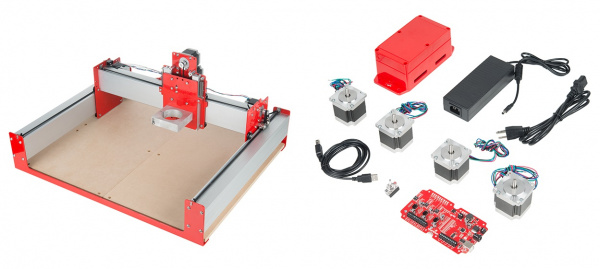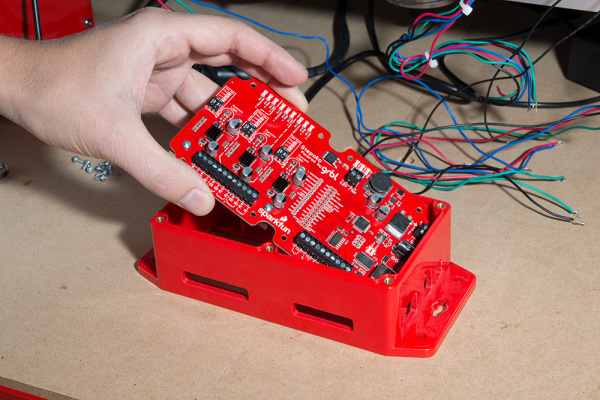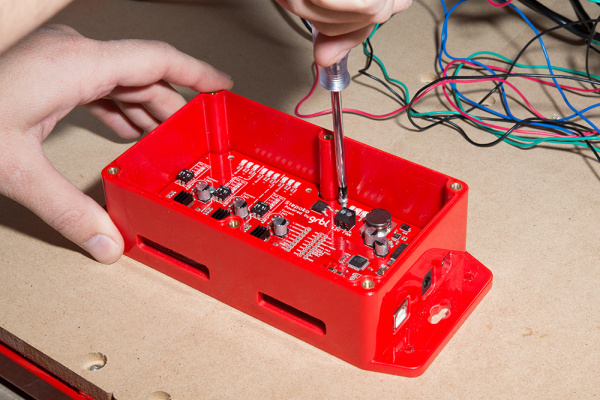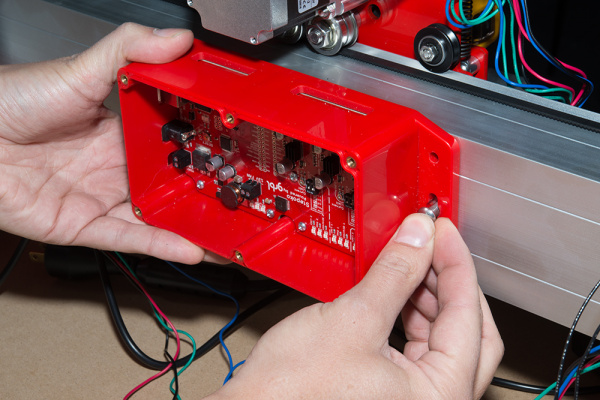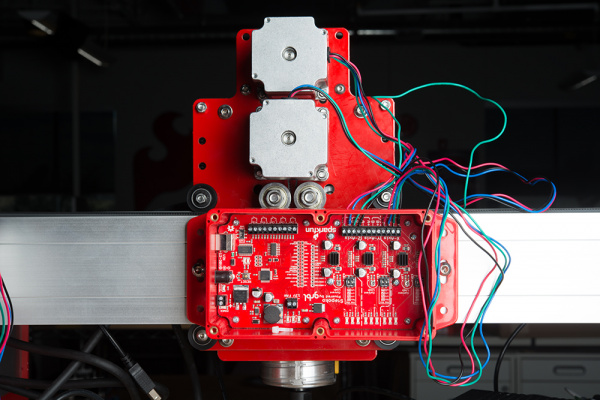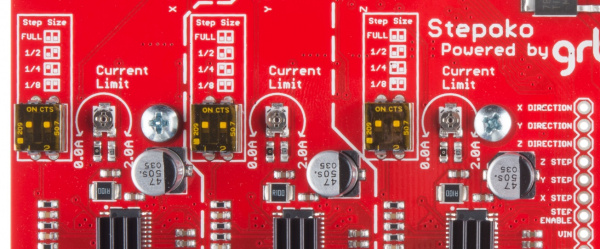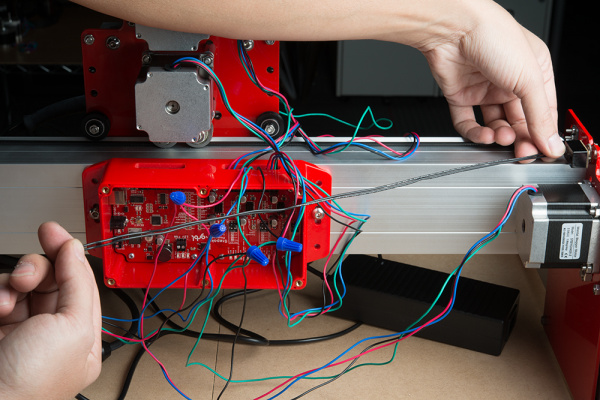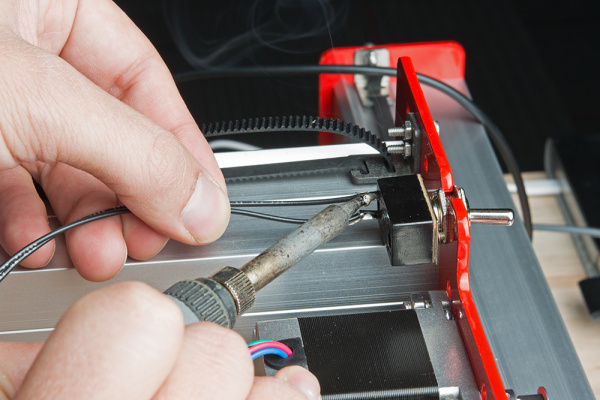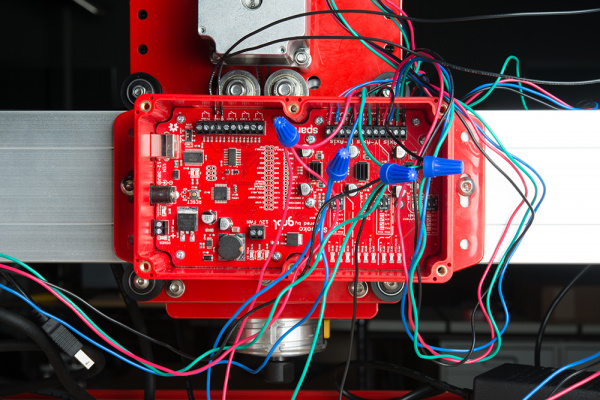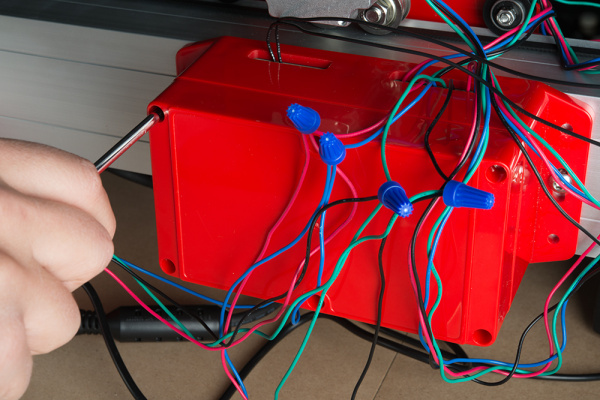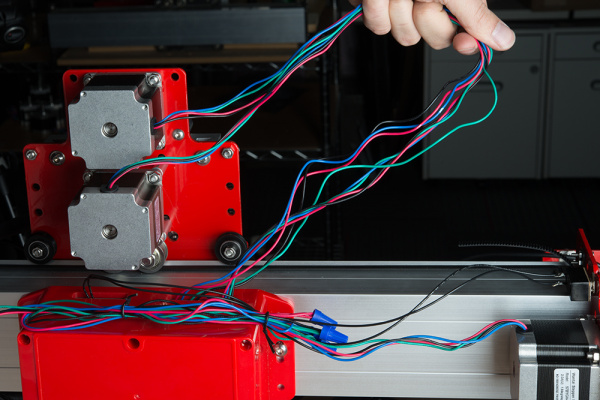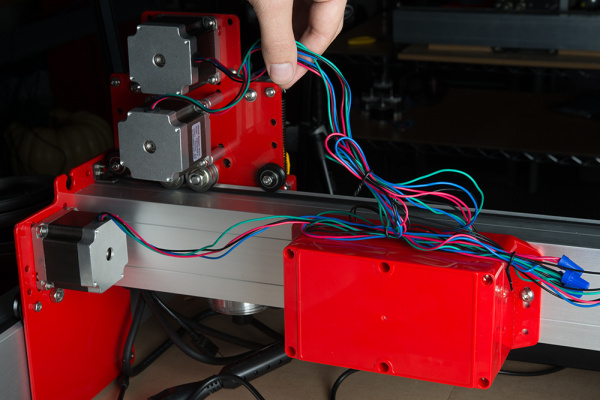Shapeoko Assembly Guide a learn.sparkfun.com tutorial
Available online at: http://sfe.io/t456
Introduction
SparkFun’s Deluxe Shapeoko kit is a Carbide3D Shapoko 3 in fancy SparkFun red with our open source 3 axis mill driver, the Stepoko.
The full kit. In this picture, the Shapeoko parts have been assembled as per the Shapeoko guide, and the SparkFun kit parts are shown beside it.
Guide Content
This guide directs you to the Shapeoko assembly instructions, then goes through the final steps to add the electronics to the mill.
Required Materials
- Shapeoko assembly instructions - Download and read before unboxing. It works well to print two pages per sheet in order to have a copy on hand, and to save trees.
- A meter or so of spare wire.
- A soldering iron and some solder.
- A multimeter.
- A 2.5mm hex wrench for belt clips.
- Pliers or small adjustable wrench.
Suggested Reading
Stepoko guide - This guide talks about how the Stepoko control electronics works. Important information is also linked below.
Assembly
Follow the Shapeoko assembly instructions until you get to the part where controller is added. There are a few differences, for instance the motors in this kit have equal length wires, but nothing too significant.
Set Aside Some Time It may take about four hours to complete the initial assembly. Once you’ve got it, continue on.Install the Shapeoko into the enclosure. There are 10 4-40 screws for this purpose, but you’ll only need 8. Use a number 1 phillips screwdriver.
![alt text]()
To get the Stepoko into the enclosure, put the ‘port end’ in first. ![alt text]()
Installing the 4-40 screws Install the enclosure to the rail with the terminal connections at the top. Use the extra M6x12mm bolts provided with the Shapeoko.
![alt text]()
Mounting the controller Connect the X and Z axes to the Stepoko. For more information, check the Stepoko guide’s Hardware: Connecting the Motors section.
- Tin the wire ends with some solder.
- Identify which pairs of wire are connected inside the motors with your meter.
- Match the coils to the winding symbols on the Stepoko. Either polarity or A-B position will work, but may make the motors spin the other way. This can be changed in software.
![alt text]()
The X and Z axis are connected. Connect the Y axis. But wait! It has two motors that are wired in parallel.
If two stepper motors are connected in parallel, they may not spin in the same direction because the internal polarities may not be the same. The solution to this problem is to transpose the colors of one pair of coil wires. This polarity/spin direction problem is compounded by the fact that the motors are mirrored on the mill and actually need to spin different directions.
Watch the video below go get a basic idea, then work through these steps.
- Connect short leads to the Y axis terminals.
- Identify the coils.
- Group one coil from each motor together by color, except with reversed polarities.
- Twist the ends to test.
- Try and move the mill in the Y axis. If it moves smoothly, solder the wires and apply heatshrink/electrical tape, or use wire nuts.
- If the axis moved roughly, unlike the X and Z axes, filp one of the pairs of coils so that it has the same colors combined, but leave the other reversed. This is because the motor’s coils are not always wired the same internally.
Take a quick look at this video to see, and hear, how the Y axis when wired incorrectly, and correctly. Set the motor drive currents. Make sure the trimpots are in the center for 1A service until you are more experienced. Or, read up on how the current setting works in the Stepoko Guide’s Hardware: Setting the current section.
![alt text]()
The trimpots are centered for 1 A drive in this photograph. Mount the switch to a free hole on the gantry end plate and solder on leads.
![alt text]()
Here the switch has been mounted and the switch wires are being measured. They go into the two terminals labled E-Stop. ![alt text]()
Soldering on the leads. ![alt text]()
All of the wires are added for this mill setup. Screw in the lid to the enclosure using a number 1 or 2 phillips.
![alt text]()
Collect your wires and bind with twist ties or zip ties.
![alt text]()
The Y axis wires have been twist tied together here. The X and Z axes are gently pulled out to see how long they are. ![alt text]()
With the X axis moved ofer to one end, I can see that my bound wires have enough slack so that they won’t be pulled on when the carriage moves. Connect the power supply, power cord, and USB cord between your computer and the Stepoko
Open up the Universal Gcode Sender, open the Stepoko’s serial port, and select the machine control tab. Set the switch to ‘ON’ and try to move the machine by computer control. If the axis move in the wrong directions to your liking (but of course, up should be positive Z), switch the direction bit field accordingly. Use the Stepoko guide’s Software: Machine Control section for more information about grbl, or check out grbl’s Github wiki for more information on changing settings.
Measure know movements and calibrate each axis. See the Stepoko guide’s Firmware: Configuring grbl and Calibrating section for more info.
You’re done!
Resources and Going Further
Here’s some links and projects you may find useful.
- Stepoko Hookup Guide– Read in-depth about the Stepoko.
- The Stepoko GitHub Repository– Schematics and Gcode examples.
- The grbl GitHub Repository– Link to grbl source and wiki, for settings information.
- See this Shapeoko Coaster Project for an example of drawing and milling a complete project.
Or, head back to the The Stepoko and Shapeoko Landing page to see what accessories and tools are available.
Now that you have built your Shapeoko Mill, check out these other SparkFun tutorials to learn how to use the SparkFun Stepoko Control board.
Once you’re familiar with the Stepoko, create your first project by following along with the Shapeoko SparkFun Coaster.
Shapeoko Coaster Project
November 20, 2015
learn.sparkfun.com |CC BY-SA 3.0 | SparkFun Electronics | Niwot, Colorado
